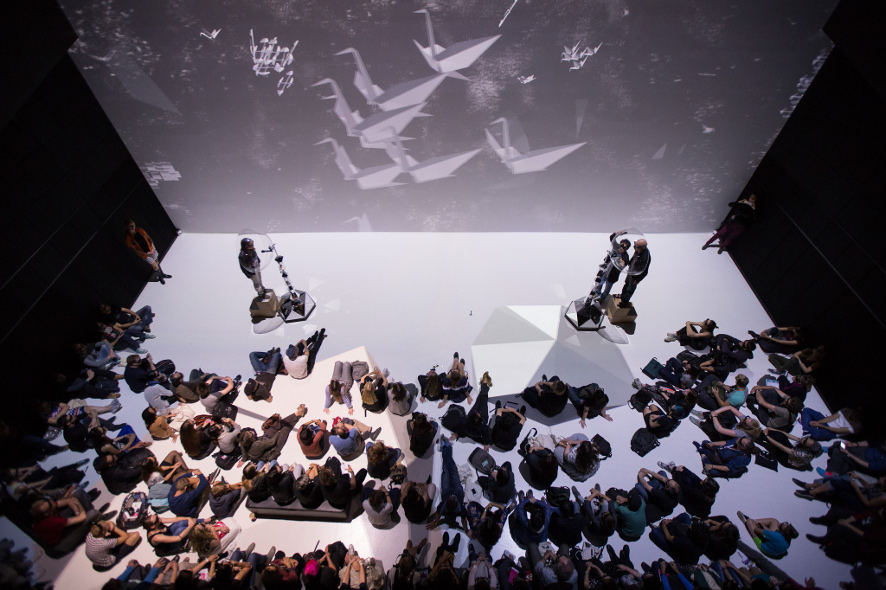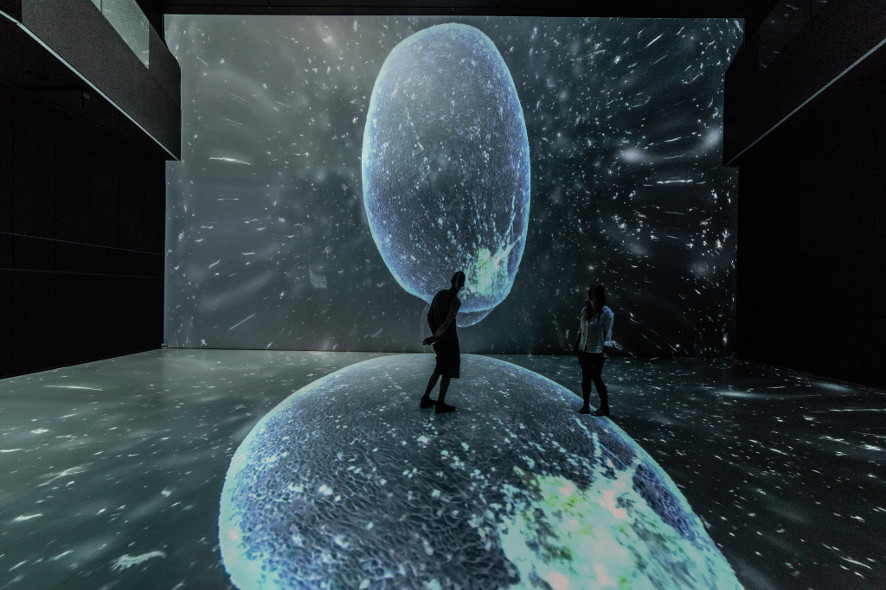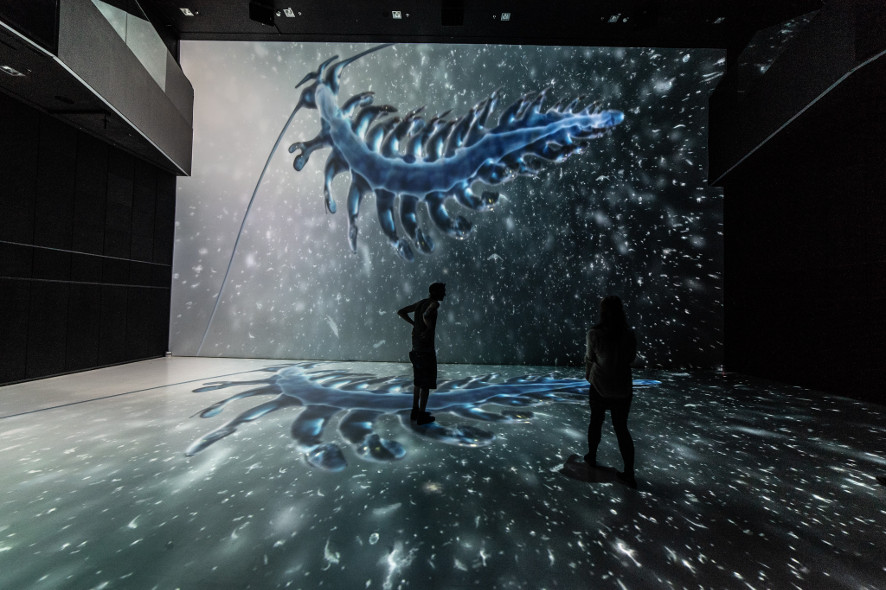Whales and dolphins in particular are highly sensitive to noise. They flee and lose their bearings. In the worst case, they are stranded ashore and die in agony. But, not much is known or noticed about the effect of noise on the microorganisms in our oceans and seas. Victoria Vesna, artist and professor at UCLA, believes that these microcosms are severely affected by our waste and noise pollution. Together with Alfred Vendl, director of the Scientific Visualization Lab at University of Applied Arts Vienna, United Motion Labs, NYU Steinhardt, University of Veterinary Medicine Vienna and the Department of Integrative Zoology at the University of Vienna, she developed the Noise Aquarium, which will be presented at the Ars Electronica Festival 2018 in Deep Space 8K.
Noise Aquarium is a truly interdisciplinary work with the artist collaborating with scientists and technologists to amplify the importance of this subject. Victoria Vesna worked with Alfred Vendl’s PhD student in scientific visualization, Martina Fröschl who utilized 3D-scans of these micro creatures obtained with unique scientific imaging techniques by scientists Thomas Schwaha and Stephan Handschuh. The interactive aspect is specially programmed for Deep Space by Glenn Bristol and sound spatialization was recorded at Harvestworks in NY by Paul Geluso from NYU Music technology.
The audience will dive into a huge 3D aquarium in Deep Space 8K, which contains various plankton species the size of whales. The mere presence of the audience generates noises that influence the plankton. In this interview Victoria Vesna tells us how.

Credit: Karina Lopez
Last year at the Ars Electronica Festival at “Bird Song Diamond”, you were busy with birds. This year we dive into the underwater world. What fascinates you about the combination of media art and biology?
Victoria Vesna: The animal kingdom came to me unsolicited – a call of the wild to those of us who are sensitive enough to pick up the signals. Before Bird Song Diamond were butterflies (Blue Morph) and in between all a zodiac of animals (Hox Zodiac).
Sounds of metamorphosis of a chrysalis into a butterfly recorded in James Gimzewski’s lab used in the Blue Morph installation attracted interest from evolutionary biologist Charles Taylor who approached me to participate in his NSF funded research on mapping the acoustic network of birds. I started listening to my environment and noticing the complexity of bird song and wanted to share this experience with the audience. On the other hand, the visualization of the blue morpho wings inspired Dr. Alfred Vendl to challenge me to conceptualize a work that utilizes some of his amazing visualizations. I was very impressed by the stunning images, the diversity and beauty of the planktons that look like aliens when magnified, but not sure what to do at first. Meditating on these creatures, I started to wonder how noise pollution affects them and discovered that little is understood about the bottom of our food chain – the microbiome of the waters that sustain our planet.
Many media artists now are responding to the call and (re)connecting with the complexity our own biology and ecology. We feel an urgency right now as we are on the brink of environmental disasters and only when we see ourselves as animals will we start to shift our habits and check our value systems.

Bird Song Diamond, Credit: Florian Voggeneder
This 3D aquarium contains 3D scans of various plankton species. Why did you choose the microcosm and not the larger sea animals?
Victoria Vesna: Actually, as many of us, I was already shocked by some of the images of whales and dolphins affected by noise pollution, and as I learned more about planktons, I wondered how noise pollution affects these micro creatures.
Scientists believe that phytoplankton contribute between 50 to 85 percent of the oxygen in Earth’s atmosphere. For instance, recently I read that Dr. Sylvia A. Earle, a National Geographic Explorer estimated that planktons provide the oxygen for one in every five breaths we take. The health of all organisms – bottom up – is related to the phytoplankton and that does not exclude us. And, when I saw the video of the plankton eating micro-plastics, I was truly alarmed and motivated to make this work as widely distributed as possible. Between the noise and plastics, the microbiome of the oceans and seas is being systematically destroyed by humans and the entire food chain is affected.
This year again “Noise Aquarium” is about sounds. Last year, visitors had to imitate bird songs. This time the participants generate noises solely through their presence. How important is the interaction with the audience in all your works?
Victoria Vesna: Biodiversity and complexity is what connects these projects and in both cases, sound is critical. In relation to the audience, I am interested in immersion and experience. To immerse people in the sounds and images that they influence with their behaviour is in my opinion the most effective way to deliver an urgent message. Blue Morph immersed the audience in the sounds of metamorphosis of a chrysalis into a butterfly, Bird Song Diamond had audiences experience complexity of bird song through mimicry and by extension the message was importance of listening to the environment we all share. Noise Aquarium connects the audience to the diversity and beauty of these micro-creatures and by creating the noise and the destruction of the eco-system with our presence, we are asked to rethink our approach to living on this planet.

Credit: Victoria Vesna
What happens in the aquarium when visitors make noise?
Victoria Vesna: A member of the audience is invited to stand on the interactive platform designed and programmed by Glenn Bristol – they generate destructive anthropocentric noise until perfectly centred at which point all the plankton return and we hear whale song – reminder that we are both at the the top of the food chain and affected equally.
In the last 60 years, underwater noise across all frequencies has increased by orders of magnitude. The sounds from shipping, offshore drilling, ocean floor mapping, and construction are permeating the furthest reaches of the ocean. And due to the extraordinary conductive nature of water, sounds generated in one location can travel and be detected from thousands of miles away! Researchers at Curtin University and University of Tasmania (both in Australia) report that blasts from a seismic air gun caused a two-to-threefold increase in dead zooplankton within 24 hours of exposure, as compared to control groups. In addition, abundance decreased by half in more than 50 percent of the species observed. We have to flip our focus from the top level of the food chain to the bottom – as nanotechnologists are doing in science, as nature works – bottom up!
The theme of this year’s Ars Electronica Festival is “Error – the Art of Imperfection”. The fact that humans have such a negative influence on the life or habitat of animals in order to allegedly improve their own lives is one of the greatest human mistakes or errors. Do you think people will change at some point?
Victoria Vesna: Although I tend to get pessimistic at times, when I meet with young students, I have hope. We are in the midst of a paradigm shift and it is disturbing to watch all the errors of the past coming to light. I believe that education is the most progressive form of activism and learning from our mistakes and errors is the best approach. Change is inevitable and we are experiencing a push back from those who are afraid of the unknown or not able to shift their habits and values. I believe that the human survival instinct is very strong and if we (re)connect ourselves to the sentient beings that are part of our collective, interconnected ecology and pay attention to the web of life, our technological developments can shift and we have an opportunity to advance as co-creators. I believe in the new generation who are viewing with horror the mess that was created and are actively reconsidering the value systems that brought us to this point.
The Deep Space 8K at the Ars Electronica Center will be open during the Ars Electronica Festival from September 6-10, 2018 from Thursday to Sunday from 10 AM to 8 PM and Monday from 10 AM to 6 PM.
To learn more about Ars Electronica, follow us on Facebook, Twitter, Instagram et al., subscribe to our newsletter, and check us out online at https://ars.electronica.art/news/en/.
